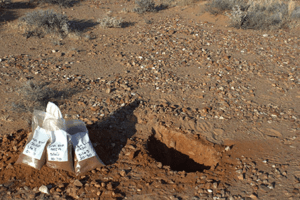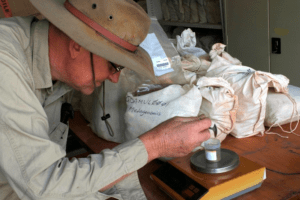New research by New York’s Rockefeller University using TERN data collection methods is helping discover small molecules that are an important resource for new drug discovery, and the environmental conditions that favour their creation. The findings provide unprecedented insights into how best to conduct future surveys for natural product pharmaceutical discovery.
Whether it be from plants on land, animals in the ocean or microbes in the ground, molecules from nature play a vital role as the starting material for drug discovery.
These naturally occurring molecules are made by organisms that, in their Darwinian struggle for survival, produce potent biological activities against their neighbouring organisms, which are often bacteria and fungi.
Once discovered by humans, these molecules can be quickly adapted for medical uses such as antibacterial, antifungal, antiparasitic and immunosuppressant drugs and medicines.
Although these molecules— generally called bacterial bioactive metabolites—have been one of the most prolific natural sources for drug development, very little is known about the distribution of the organisms that produce them in natural environments. Furthermore, previous efforts for molecular discovery have focused on organisms that can be cultured in the laboratory, a historically successful process but one that ignores the vast majority of microorganisms that are believed to live in soils.
New research is helping fill this information gap by analysing the environmental factors that contribute to differences in the composition of soil metabolites. Researchers from New York’s Rockefeller University and The University of Adelaide have used genetic techniques to assess the metabolic potential of soils collected from TERN’s network of hundreds of environmental surveillance plots and housed in the TERN Ecosystem Sample Library.
The team compared these genetic sequencing data with environmental data collected by TERN at each site to look for factors, such as vegetation type, soil pH and geographic location, that correlated with either high metabolite richness or changes in composition.
“Contrary to long-held beliefs, we found that differences in vegetation do not directly govern differences in bacterial bioactive metabolite composition,” says Dr Christophe Lemetre of Rockefeller University and co-lead author of the team’s just published paper in the PNAS Journal.
“Rather, we found that bacterial metabolite composition correlates most closely with latitude, and to some extent with soil pH,” says Christophe.
The team analysed 397 soil samples collected from 16 different ecotypes—including native and non-native vegetation, forests, shrublands, woodlands and grasslands—spanning Australia’s rangeland and coastal environments.
“Without samples and data from TERN’s ecosystem surveillance plots, this work wouldn’t have been possible,” comments Christophe. “Access to soil samples from sites with such highly varied latitudes alongside data on environmental variables was a key factor in enabling this research.”
“Whilst the underlying causes of differences in composition remain unknown, the significant correlation we found with latitude provides insight into how best to conduct future surveys for natural product drug discovery efforts.”
- Read more about this research and its findings here
- Download TERN’s specimen loans information sheet to find out how you can use TERN samples. To discuss opportunities to use our samples please contact Ben Sparrow.
- TERN’s plot and transect based ecosystem surveillance data are now openly available for download via the TERN AEKOS data portal.
Published in TERN newsletter November 2017










